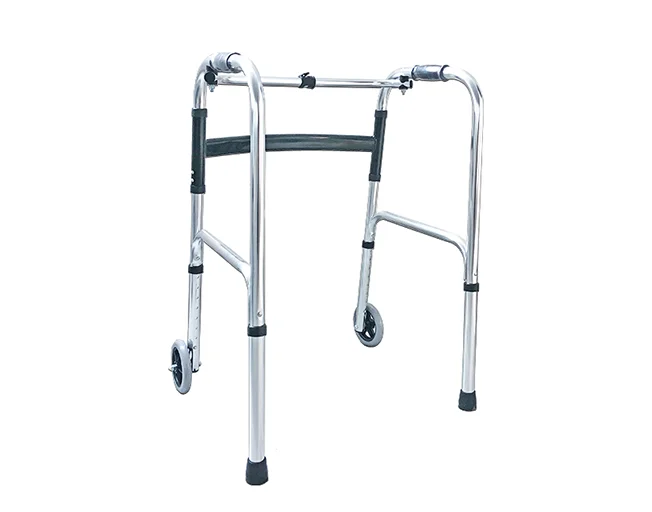Choosing Walking Frames for the Elderly: Key Factors Experts Should Evaluate
Time : Aug 28, 2025 View : 1,490
When mobility starts to wane, especially for older folks, it can really hit their independence and daily comfort hard. A walking frame isn’t just about giving a bit of support—it’s gotta be safe, comfy, and fit the person’s unique needs. Everything matters here: their physical shape, the space they move in, and how the frame’s built. This guide’s packed with practical tips for pros who need to pick or suggest the best walking frames for elderly users.

Looking for reliable mobility aids that blend comfy design with tough, medical-grade build? Check out XUNYU. They focus on smart, user-friendly engineering to tackle the real struggles seniors and caregivers face. Their lineup’s got it all—from light, easy-to-carry walkers to sturdy rollators—covering every kind of mobility need out there.
Checking the User’s Physical Condition
Picking a walking aid means making sure it fits the user’s physical abilities. Get it wrong, and you’re looking at discomfort or even injuries.
- Evaluating Strength and Balance Capabilities: Start by checking how strong their arms are and how well they balance. Weak arms? Non-wheeled frames or heavy models might be tough to handle. A shaky balance could call for something with four-point support or a wider base for extra steadiness.
- Considering Height, Weight, and Posture: The frame’s gotta match the user’s body. Too tall or too short, and it’ll mess with their shoulders or back. A quick trick? Measure from their wrist crease to the floor with arms relaxed to nail the right handle height.
- Identifying Specific Mobility Limitations: Whether it’s recovery from surgery or conditions like arthritis or Parkinson’s, knowing exactly what’s limiting them helps. Do they need a seat? Forearm supports? Those details make all the difference.
Different Types of Walking Frames
Once you’ve got a handle on their needs, it’s time to look at frame options that fit while keeping things flexible for changes down the road.
- Rigid Frames vs. Folding Frames: Sturdy rigid frames are rock-solid but can be a pain to move or store. Folding ones are great for folks who travel a lot or live in tight spaces where you need something compact.
- Wheeled vs. Non-Wheeled Options: Two-wheeled walkers give a bit of help moving forward while still keeping some control. Four-wheeled ones glide smoothly but need better coordination. Non-wheeled frames? You gotta lift ‘em a bit with each step, so they’re only good if the user’s got enough upper body strength.
- Adjustable and Customizable Features: Height-adjustable legs are a must for good posture. Some frames let you add stuff like brakes, baskets, or even seats—super handy for folks whose needs might shift over time.
Key Design Features to Examine
Design elements can significantly impact both usability and longevity of walking frames for elderly individuals.
Frame Material and Durability: Aluminum offers lightweight maneuverability without compromising strength—ideal for frail users. Steel frames provide higher weight tolerance but at the cost of added heft.
Handle Design and Grip Comfort: Ergonomic handles reduce wrist fatigue during extended use. Foam grips offer comfort but wear faster; rubberized grips provide better durability and hygiene control.
Wheel Configuration and Braking Systems: Larger wheels improve outdoor navigation, while swivel front wheels enhance indoor maneuverability. Braking systems—especially loop-style hand brakes—are critical in preventing slips on inclines or uneven terrain.
Suitability Across Different Environments
You must consider where the frame will primarily be used since different environments pose unique challenges.
- Indoor Maneuverability and Compactness: Narrow doorways and tight corners necessitate compact designs with swivel wheels. Foldable frames also make storage easier in confined living areas.
- Outdoor Stability and Terrain Adaptability: Outdoor use demands robust construction with larger wheels capable of handling gravel paths or uneven sidewalks without tipping over easily.
Safety Considerations for Daily Use
Safety isn’t just about preventing falls—it’s about ensuring long-term reliability under daily stress conditions.
- Load Capacity and Structural Integrity: The XY913L-5 model is designed with reinforced aluminum alloy tubing that supports up to 136kg (300lbs), ensuring dependable performance even under continuous load. This makes it suitable for most elderly users without compromising on weight efficiency during transport.
- Weight Limits in XUNYU Product Lineup: The XY913L-5 exemplifies how high-capacity walkers don’t have to sacrifice portability—a crucial factor when recommending devices for heavier patients who still prioritize independence.

- Anti-Tip Design Elements: Frames designed with widened bases reduce tip-over risk significantly during sudden directional changes or slope navigation. Some XUNYU models feature anti-rollover stabilizers integrated into their base design, providing extra reassurance, particularly when navigating curbs or ramps outdoors.
Customization and Accessories Integration
Accessories transform basic frames into multifunctional tools tailored to individual lifestyles.
- Seat Attachments and Rest Options: For users prone to fatigue during ambulation, integrated seats allow them to rest safely without needing additional furniture nearby—especially useful during errands outside home environments.
- Storage Compartments for Personal Items: Built-in baskets or detachable pouches make it easier to carry essentials like medications, phones, or groceries without requiring additional bags that could affect balance.
Maintenance, Cleaning, and Durability Over Time
Ease of upkeep contributes directly to hygiene standards as well as the long-term cost-effectiveness of your recommendation.
- Ease of Disassembly for Cleaning Purposes: Models that allow tool-free disassembly simplify routine cleaning—a key requirement in institutional settings where sanitation protocols must be followed rigorously.
- Replacement Parts Availability from XUNYU: XUNYU provides ongoing access to replacement components such as brake cables, wheels, grips, and seat cushions, ensuring continued usability even after years of service life (XY913L-5).
Recommendations Based on User Profiles with XUNYU Products Integrated
Matching user profiles with specific models ensures optimal performance across varying degrees of mobility impairment:
- For Users with Mild Mobility Issues – XUNYU Lightweight Walker Series: These walkers offer minimal resistance while providing just enough support during the early stages of mobility decline—ideal for post-surgical recovery patients regaining confidence in movement patterns.
- For Moderate Support Needs – XUNYU Foldable Frame with Wheels: Folding designs equipped with front casters strike a balance between maneuverability and support—perfectly suited for semi-active seniors navigating both home interiors and public spaces comfortably.
- For Advanced Stability Requirements – XUNYU Heavy-Duty Rollator: Heavy-duty rollators like XY913L-5 accommodate higher weight capacities while incorporating features like padded seats and secure braking systems—ideal for those requiring full-time assistance yet desiring autonomy in movement routines.
Professional Evaluation Protocols
To ensure clinical accuracy when prescribing walking frames:
Use standardized gait analysis tools combined with patient history reviews to determine whether static support (non-wheeled) or dynamic mobility (rollators) is more appropriate based on diagnosis severity levels.
Trial fittings allow real-time adjustments using demo units from XUNYU’s product line, helping clinicians fine-tune handle height, wheel resistance settings, and accessory placements before finalizing recommendations.
FAQ
Q: What kind of walking frame works best on bumpy outdoor ground?
Four-wheeled walkers with big wheels handle rough terrain way better. They soak up bumps and keep things steady compared to basic two-wheel models. Check out something like the XY913L-5—it’s built tough for rugged outdoor use.
Q: How do I figure out if a walker fits me right?
Stand up straight inside the frame, arms hanging loose. The handles should hit around your wrist level. That way, your elbows bend just a bit—say 15 to 30 degrees—when you grab them. Keeps you comfy and in control without straining.
Q: Can I slap on extras like trays or bags later?
Yup! Lots of good walkers are made to let you add stuff like trays, baskets, or even oxygen tank holders. You can tweak them as your needs change without having to buy a whole new frame.


